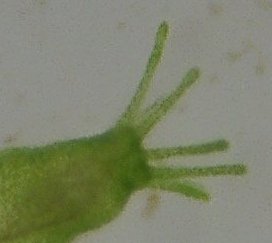Correct!
Mystery Picture Answers
No. 22
|
|
A species of freshwater Hydra. A fascinating tiny animal (some are only barely visible to the naked eye when not outstretched, but others can reach 10-30mm long) found in freshwater ponds and slow-moving rivers where it attaches itself to plants or rocks. It then uses its tentacles (up to 10 of them) to catch its prey such as water fleas as they float past. Stinging cells are used to stun the prey and the tentacles then pass it to the hydra's mouth. Freshwater hydras are related to jellyfish, corals and sea anemones, and are able to turn their body inside-out through their mouths. If they are broken up into pieces, most of these pieces can regenerate into complete new hydras! Hydras are able to reproduce in two ways; in the summer they 'bud' tiny new hydra individuals which then break off and become independant, or in the winter, sexual reproduction takes place with sperm being released into the water to fertilise eggs retained in the body wall of female hydra. Only one species of green hydra occurs in Britain and Europe and is called Chlorohydra viridissima. Its green colour is due to tiny alga which live within the hydra's body. These alga use energy from the sun to photosynthesise, releasing oxygen which is used by the hydra. At the same time the hydra provides byproducts such as carbon dioxide, nitrogen based substances and phosphates which are of direct use to the alga. This mutually beneficial relationship is called a symbiotic relationship. If the hydra fails to catch enough animal prey it can digest the alga within itself and then later take in more living alga from the water to replace it. Sometimes, under the microscope, tiny animals can be seen living on the surface of hydras. They perform a cleaning role, removing bacteria from the surface. |
|
Back to Mystery Picture Gallery

